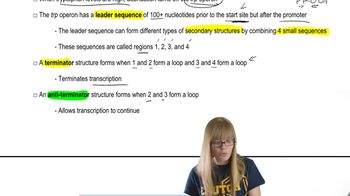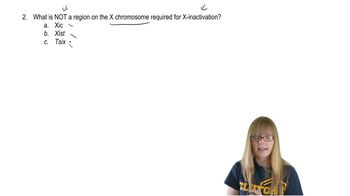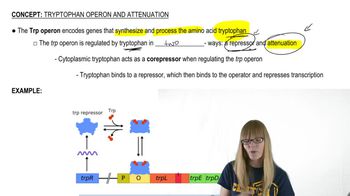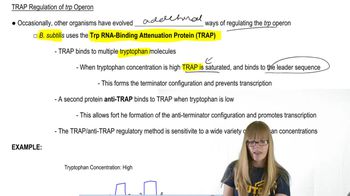Table of contents
- 1. Introduction to Genetics51m
- 2. Mendel's Laws of Inheritance3h 37m
- 3. Extensions to Mendelian Inheritance2h 41m
- 4. Genetic Mapping and Linkage2h 28m
- 5. Genetics of Bacteria and Viruses1h 21m
- 6. Chromosomal Variation1h 48m
- 7. DNA and Chromosome Structure56m
- 8. DNA Replication1h 10m
- 9. Mitosis and Meiosis1h 34m
- 10. Transcription1h 0m
- 11. Translation58m
- 12. Gene Regulation in Prokaryotes1h 19m
- 13. Gene Regulation in Eukaryotes44m
- 14. Genetic Control of Development44m
- 15. Genomes and Genomics1h 50m
- 16. Transposable Elements47m
- 17. Mutation, Repair, and Recombination1h 6m
- 18. Molecular Genetic Tools19m
- 19. Cancer Genetics29m
- 20. Quantitative Genetics1h 26m
- 21. Population Genetics50m
- 22. Evolutionary Genetics29m
12. Gene Regulation in Prokaryotes
Tryptophan Operon and Attenuation
Problem 25a
Textbook Question
What is the likely effect of each of the following mutations of the trpL region on attenuation control of trp operon gene transcription? Explain your reasoning.
The entire trpL region is deleted.
 Verified step by step guidance
Verified step by step guidance1
Understand the role of the trpL region: The trpL region, also known as the leader sequence, is crucial in the attenuation mechanism of the trp operon. It contains sequences that form stem-loop structures, which are involved in the regulation of transcription termination.
Recognize the function of attenuation: Attenuation is a regulatory mechanism that controls the termination of transcription in response to tryptophan levels. In the presence of high tryptophan, the ribosome quickly translates the leader peptide, allowing the formation of a terminator hairpin that halts transcription.
Consider the effect of deleting the trpL region: Without the trpL region, the leader peptide cannot be synthesized, and the necessary stem-loop structures for attenuation cannot form. This would likely prevent the attenuation mechanism from functioning.
Predict the outcome on transcription: With the attenuation mechanism disabled, transcription of the trp operon would proceed regardless of tryptophan levels, leading to continuous expression of the operon genes.
Summarize the impact: The deletion of the trpL region would likely result in a loss of attenuation control, causing constitutive expression of the trp operon, as the regulatory mechanism for halting transcription in response to tryptophan levels is absent.
Recommended similar problem, with video answer:
 Verified Solution
Verified SolutionThis video solution was recommended by our tutors as helpful for the problem above
Video duration:
2mPlay a video:
Was this helpful?
Key Concepts
Here are the essential concepts you must grasp in order to answer the question correctly.
Attenuation Control
Attenuation control is a regulatory mechanism in prokaryotes, particularly in the trp operon, that modulates gene expression based on the availability of tryptophan. It involves the formation of specific RNA structures during transcription that can either promote or inhibit the continuation of transcription depending on the cellular conditions. This process allows bacteria to efficiently respond to nutrient availability.
Recommended video:
Guided course

Trp Attenuation
trp Operon
The trp operon is a cluster of genes in bacteria that encode enzymes necessary for the biosynthesis of the amino acid tryptophan. It is regulated by both repression and attenuation mechanisms, allowing the cell to conserve resources when tryptophan is abundant. The operon consists of structural genes, a promoter, and regulatory sequences that respond to tryptophan levels.
Recommended video:
Guided course

Trp Attenuation
trpL Region
The trpL region, or leader sequence, is a short segment of RNA located upstream of the structural genes in the trp operon. It contains sequences that can form alternative secondary structures, influencing the transcription process. Deletion of the trpL region disrupts these structures, which can lead to the loss of attenuation control, resulting in continuous transcription of the operon regardless of tryptophan levels.
Recommended video:
Guided course

Regions of X Chromosomes





